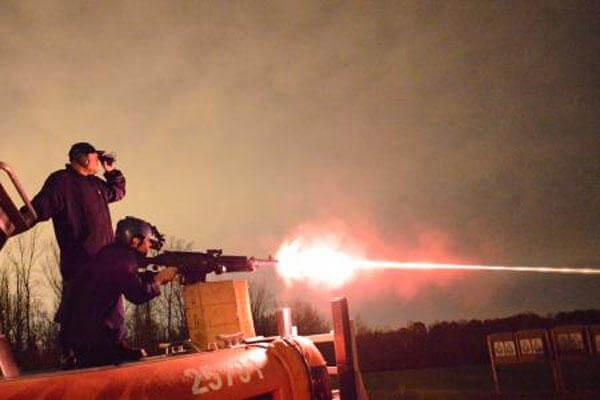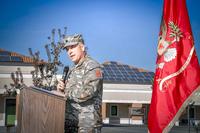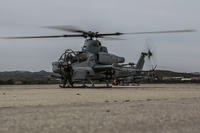A chill breeze blew through the Kentucky hills as the last rays of sunlight cast their golden rays over the Fort Knox small arms range and faded into darkness.
The landscape stood silent other than the occasional coyote sniffing through the underbrush or the hoot of an owl on a far away ridge.
The chatter of machine guns and the angry red glow of tracer rounds finding their targets downrange suddenly broke the serene silence. It was time to train.
In the spring of 2007, after considering several possible alternatives to live fire training on the pristine Great Lakes, the Riverine Range at Fort Knox became the mounted automatic weapons training facility for the Coast Guard 9th District, and has been crucial to the mission readiness of the stations with mounted automatic weapons carriage requirements.
Assembling the right group of people to make up the training staff is no easy task. The challenge of developing the program and assembling the training staff fell to the 9th District’s Enforcement Branch and subject matter expert, Master Chief Petty Officer Patrick O’Kelly.
O’Kelly led this year's training team, which consisted of 18 Coast Guardsmen from around the district. The team was drawn from active-duty units, as well as the Coast Guard Reserve and Auxiliary. The team is responsible for training, on average, 220 tactical coxswains and crew members over the course of two months every year.
It’s kind of amazing that the training team can pull this off, said O’Kelly. While planning starts months in advance, the team only had ten days to mobilize, arrange the facilities and form a cohesive unit.
Even though O’Kelly has led the training team for eight of the nine annual training evolutions, the challenge of getting the team unified on the same page in less than two weeks time was immense.
“The unification part was building the camp because we come down here with nothing permanent in place,” said O’Kelly. “Everybody works together to set up the command post, simulator, dining facilities, training room, and to set up the firing range out on the river. That’s where they really got the unification.”
Having that unification and focus plays a big role in the quality of training, however keeping that unification and focus was a job in and of itself. On aspect of the team’s leadership is a volunteer. Auxiliarist David Linder, a former Marine who is currently attached to Coast Guard Station Sodus Point, N.Y., was essential to the team’s unity.
Linder has voluntarily cooked for the MAW training staff since 2007 during eight of the nine iterations of the course. Linder volunteers to prepare meals and provide logistical support to the instructors and students. One of the many benefits comes from the help of his trusty sidekicks — two propane grills.
“I took a five-year apprenticeship as a chef,” said Linder. “To me, this is no different from working in a professional kitchen — it’s still heat — it’s just a different kind of heat.”
Linder has used his grills to great effect, making some meals you would typically associate with a grill and some meals that leave you scratching your head and asking for the recipe, like his walnut bread or lemon pound cake French toast.
With people like Linder in the kitchen, the team can focus on the training — very detailed training.
“He is a unifying force based on the time and effort he puts into his meals,” O’Kelly said. “The training team knows that he is here for them, so they put in that much more effort out on the firing line. This would not be the same program without Dave.”
At the start of each training course was a safety brief, followed by a complete familiarization of every weapon that the trainees used during the three-day course.
After the weapons familiarization was completed, the trainees enter a mobile weapon simulator to further familiarize themselves and demonstrate their knowledge of the weapon, communications and techniques, tactics and procedures.
“If that’s where they make a terrible mistake, it’s a simulator. That’s what it’s for,” said O’Kelly. “We can stop it right there and show them exactly what they did wrong and show them proper TTP and how to improve.”
The trainees were provided the opportunity to shoot the same course of fire in the simulator that they will shoot on the life fire range to qualify. Other simulated courses were available to evaluate the crew’s communication and comfort with the weapons.
O’Kelly mentioned that he has seen a vast improvement in the qualifying scores because of the time spent in the simulator.
Trainees were then provided the opportunity to complete the machine gun boat course for qualification. Once trainees fired and qualified on the live range, they were ready to crew the weapon in the operational environment, however, the District’s training course goes above and beyond the qualification requirements to enhance their proficiency of handling the weapons should the need arise.
The training day continued after dusk with a night shoot, using night vision goggles and infrared sights, to help prepare the trainees to operate the weapon in a totally dark environment. Nighttime live-fire helped crews demonstrate their knowledge and familiarity of the weapons. The weapon was the same; however the field of fire and tracer rounds gave a completely different view at night. Crews needed to visualize how the weapon handled and demonstrate key muscle memory when there was no light.
The second day of training, the crews utilized Fort Knox’s Riverine Range on the Salt River. The course, which consists of multiple targets place in various locations along the riverbank, was designed to help trainees become familiar and proficient with operating the weapons in the maritime environment, as well as practice their communications skills as a boat crew ‘team’.
“Training through repetitive motion is what it boils down to,” O’Kelly said. “If you do 4,000 things four times, versus four things 4,000 times, you’re going to be much better at the things you do over and over and over.”
The last day was wrapped up similarly to the first, with a weapons familiarization in the form of thoroughly cleaning weapons and reviewing the course objectives. The weapons were prepared for the next crew.
In all, the dedication of such a diverse team of active-duty Coast Guardsmen, reservists and auxiliarists, as well as the partnership with Fort Knox, helped keep the district’s units Semper Paratus.
“The staff and facilities at Fort Knox were key to our success. The range operators were very supportive of the Coast Guard. Whatever we needed, they would accommodate,” said O’Kelly. “They know us, they trust us. I tell everyone Fort Knox is the place to train.”
For now, the MAW training at Fort Knox is complete. Trainee and trainer alike have returned to their respective units, each one more prepared to carry out the Coast Guard's missions. Gone too, like the mythical Scottish city of Brigadoon, is the camp the training team worked so hard to build. But, unlike Brigadoon, the MAW training will return again next year to start the training process all over again.




























